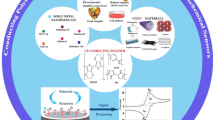Abstract
Catalytic nanotubes made from titanium dioxide (TiO2-NTs) and covered with gold nanoparticles (Au-NPs) were prepared via galvanic deposition of the Au-NPs on the TiO2-NTs. The morphology and surface characteristics of the resulting electrodes were investigated using scanning electron microscopy and energy-dispersive X-ray spectroscopy. The results indicated that the Au-NPs were homogeneously deposited on the surface of TiO2-NTs which consist of individual tubes of about 40–80 nm in diameter. The AuNPs with a size of 80–100 nm are well-dispersed on the surface of the TiO2-NTs. The electro-catalytic activity of the electrodes towards the electro-oxidation of levodopa was studied by cyclic voltammetry, differential puls voltammetry. The results showed that the electrodes exhibit a considerably higher activity toward the oxidation of levodopa. The oxidation peak current linearly depends on the concentration of levodopa in the 10 to 70 μM concentration range. Levodopa was determined by the method in pharmaceutical preparations, and results were found to be satisfactory.

Comparison of cyclic voltammograms of Au‐TiO2‐NTs/Ti and a flat gold electrode for determination levodopa.






Similar content being viewed by others
References
Weiner WJ (2002) Parkinson’s disease: diagnosis and clinical management. Medical Publishing, New York, pp 195–205
Cedarbaum JM, Williamson R, Kutt H (1987) Simultaneous determination of levodopa, its metabolites and carbidopa in clinical samples. J Chromatogr 415:393–399
Tolokán A, Klebovich I, Balogh-Nemes K, Horvai G (1997) Automated determination of levodopa and carbidopa in plasma by high-performance liquid chromatography-electrochemical detection using an on-line flow injection analysis sample pretreatment unit. J Chromatogr B Biomed Sci Appl 698:201–207. doi:10.1016/S0378-4347(97)00288-0
Teixeira MFS, Marcolino-Júnior LH, Fatibello-Filho O, Dockal ER, Bergamini MF (2007) An electrochemical sensor for l-dopa based on oxovanadium-salen thin film electrode applied flow injection system. Sens Actuators, B 122:549–555. doi:10.1016/j.snb.2006.06.032
Coello J, Maspoch S, Villegas N (2000) Simultaneous kinetic-spectrophotometric determination of levodopa and benserazide by bi- and three-way partial least squares calibration. Talanta 53:627–637. doi:10.1016/S0039-9140(00)00539-7
Zhao S, Bai W, Wang B, He M (2007) Determination of levodopa by capillary electrophoresis with chemiluminescence detection. Talanta 73:142–146. doi:10.1016/j.talanta.2007.03.023
Satheesh Babu TG, Ramachandran T, Nair B (2010) Single step modification of copper electrode for the highlysensitive and selective non-enzymatic determination of glucose. Microchim Acta 169:49–55. doi:10.1007/s00604-010-0306-4
Zhang N, Wang G, Gu A, Feng Y, Fang B (2010) Fabrication of prussian blue/multi-walled carbon nanotubesmodified electrode for electrochemical sensing of hydroxylamine. Microchim Acta 168:129–134. doi:10.1007/s00604-009-0274-8
Wu K, Hu S (2004) Electrochemical study and selective determination of dopamine at a multi-wall carbon nanotube-nafion film coated glassy carbon electrode. Microchim Acta 144:131–137. doi:10.1007/s00604-003-0103-4
Klink MJ, Crouch AM (2009) Preparation of low temperature nano-structured ZnO and RhO2 on titanium substrates, and evaluation for phenolelectro-catalytic oxidation. Microchim Acta 166:27–33. doi:10.1007/s00604-009-0157-z
Shahrokhian S, Amiri M (2007) Multi-walled carbon nanotube paste electrode for selectivevoltammetric detection of isoniazid. Microchim Acta 157:149–158. doi:10.1007/s00604-006-0665-z
Jo S, Jeong H, Bae SR, Jeon S (2008) Modified platinum electrode with phytic acid and single-walled carbon nanotube: application to the selective determination of dopamine in the presence of ascorbic and uric acids. Microchem J 88:1–6. doi:10.1016/j.microc.2007.08.005
Zhao J, Yu J, Wang F, Hu S (2007) Fabrication of gold nanoparticle-dihexadecyl hydrogen phosphate film on a glassy carbon electrode, and its application to glucose sensing. Microchim Acta 156:277–282. doi:10.1007/s00604-006-0631-9
Wang F, Hu S (2009) electrochemical sensors based on metal and semiconductor nanoparticles. Microchim Acta 165:1–22. doi:10.1007/s00604-009-0136-4
Wang C, Wang G, Fang B (2009) Electrocatalytic oxidation of bilirubinat ferrocenecarboxamide modified MWCNT–goldnanocomposite electrodes. Microchim Acta 164:113–118. doi:10.1007/s00604-008-0041-2
Shahrokhian S, Asadian E (2009) Electrochemical determination of L-dopa in the presence of ascorbicacid on the surface of the glassy carbon electrode modified by a bilayer of multi-walled carbon nanotube and poly-pyrrole doped with tiron. J Electroanal Chem 636:40–46. doi:10.1016/j.jelechem.2009.09.010
Daneshgara P, Norouzi P, Ganjali MR, Ordikhani-Seyedlara A, Eshraghi H (2009) A dysprosium nanowire modified carbon paste electrode for determination of levodopa using fast Fourier transformation square-wave voltammetry method. Colloids Surf, B 68:27–32. doi:10.1016/j.colsurfb.2008.09.019
Bergamini MF, Santos L, Stradiotto NR, Zanoni MVB (2005) A disposable electrochemical sensor for the rapid determination of levodopa. J Pharm Biomed Anal 39:54–59. doi:10.1016/j.jpba.2005.03.014
Hosseini MG, Sajjadi SAS, Momeni MM (2007) Electrodeposition of platinum metal on titanium and anodised titanium from P salt:application to electro-oxidation of glycerol. Surf Eng 23:419–424. doi:10.1179/174329407X260582
Hosseini MG, Momeni MM (2010) Gold particles supported on self-organized nanotubular TiO2 matrix as highly active catalysts for electrochemicaloxidation of glucose. J Solid State Electrochem 14:1109–1115. doi:10.1007/s10008-009-0920-4
Hosseini MG, Momeni MM, Faraji M (2010) Electrochemical fabrication of polyaniline films containing gold nanoparticles deposited on titanium electrode for electro-oxidation of ascorbic acid. J Mater Sci 45:2365–2371. doi:10.1007/s10853-009-4202-4
Hosseini MG, Momeni MM, Faraji M (2010) An innovative approach to electro-oxidation of dopamine on titanium dioxide nanotubes electrode modified by gold particles. J Appl Electrochem 40:1421–1427. doi:10.1007/s10800-010-0119-5
Hosseini MG, Momeni MM (2010) Silver nanoparticles dispersed in polyaniline matrixes coatedon titanium substrate as a novel electrode for electro-oxidation of hydrazine. J Mater Sci 45:3304–3310. doi:10.1007/s10853-010-4347-1
Zhang L, Chen G, Hu Q, Fang Y (2001) Separation and determination of levodopa and carbidopa in composite tablets by capillary zone electrophoresis with amperometric detection. Anal Chim Acta 431:287–292. doi:S0003-2670(00)01327-1
Tapan NA, Mustain WE, Gurau B, Sandí G, Prakash J (2004) Investigation of methanol oxidation electrokinetics on Pt using the asymmetric electrode. J New Mater Electrochem Syst 7:281–286
Acknowledgements
The authors would like to acknowledge the financial support of Iranian Nanotechnology Society and the Office of Vice Chancellor in Charge of Research of University of Tabriz.
Author information
Authors and Affiliations
Corresponding author
Rights and permissions
About this article
Cite this article
Hosseini, M.G., Faraji, M., Momeni, M.M. et al. An innovative electrochemical approach for voltammetric determination of levodopa using gold nanoparticles doped on titanium dioxide nanotubes. Microchim Acta 172, 103–108 (2011). https://doi.org/10.1007/s00604-010-0471-5
Received:
Accepted:
Published:
Issue Date:
DOI: https://doi.org/10.1007/s00604-010-0471-5




